Experimental and Numerical Analysis of Multiple Low-Velocity Impact Damages in a Glass Fibered Composite Structure
Abstract
:1. Introduction
2. Methodology, Material, and Approaches
2.1. Methodological Flow Chart
2.2. GFRP Material Studied
2.3. LDV Setup
2.4. SEM Numerical Approach
2.5. DIC Setup
3. Damage Analysis Methods
3.1. RRMS-Based Damage Analysis
3.2. Threshold-Based Elliptical Method in Damage Analysis
3.3. Thermal Speckle-Based Verification Method
4. Discussion on the Results Obtained
4.1. RRMS Models-Visualization of Damages
4.2. ETM-Localization of Damages
4.3. Thermal Speckle-Based Verification of Damages
5. Conclusions
- ▪
- SEM helped to model BVID separately and together (experimental data) to validate the SHM methodology.
- ▪
- The RRMS study provided results about the damage locations even near the higher-energy zones.
- ▪
- S1 provided good analyses of the results, and scanning points were taken to analyze the damage zones.
- ▪
- The threshold-based proposed ETM algorithm predicted the location of the damages.
- ▪
- The error range was less than 1%, as shown in the difference (cm) of Table 4 in all the analyzed cases.
- ▪
- DIC-based diagrams of variation in displacements differentiated the damage region and thus verified it.
- ▪
- Combined online monitoring and verification of the structure was proposed.
Author Contributions
Funding
Institutional Review Board Statement
Informed Consent Statement
Data Availability Statement
Acknowledgments
Conflicts of Interest
Appendix A
| Elastic Constant | P | Pf | Pm | η |
|---|---|---|---|---|
| E11 | E11 | E11f | E11m | 1 |
| ν12 | ν12 | ν12f | νm | 1 |
| G12 | 1/G12 | 1/G12f | 1/Gm | η6 |
| G23 | 1/G23 | 1/G23f | 1/Gm | η4 |
| KT | 1/KT | 1/Kf | 1/Km | ηK |
References
- Giurgiutiu, V. Structural Health Monitoring; Academic Press: London, UK, 2008. [Google Scholar]
- Li, J.; Lu, Y.; Guan, R.; Qu, W. Guided waves for debonding identification in CFRP-reinforced concrete beams. Constr. Build. Mater. 2017, 131, 388–399. [Google Scholar] [CrossRef]
- Stickel, J.; Nagarajan, M. Glass fiber-reinforced composites: From formulation to application. Int. J. Appl. Glass Sci. 2012, 3, 122–136. [Google Scholar] [CrossRef]
- Balasubramaniam, K.; Fiborek, P.; Malinowski, P. Lamb waves based assessment of impact damage in multilayered CFRP plate. In Proceedings of the Health Monitoring of Structural and Biological Systems XV, Online, 22–26 March 2021; SPIE Library: Belingham, WA, USA, 2021; p. 11593. [Google Scholar]
- Bogenfeld, R.; Kreikemeier, J.; Wille, T. An analytical scaling approach for low-velocity impact on composite structures. Compos. Struct. 2018, 187, 71–84. [Google Scholar] [CrossRef]
- Reis, P.; Ferreira, J.; Richardson, M. Fatigue damage characterization by NDT in polypropylene/glass fibre composites. Appl. Compos. Mater. 2010, 18, 409–419. [Google Scholar] [CrossRef]
- Miqoi, N.; Pomarede, P.; Meraghni, F.; Declercq, N.; Guillaumat, L.; Le Coz, G.; Delalande, S. Detection and evaluation of barely visible impact damage in woven glass fabric reinforced polyamide 6.6/6 composite using ultrasonic imaging, X-ray tomography and optical profilometry. Int. J. Damage Mech. 2020, 30, 323–348. [Google Scholar] [CrossRef]
- Sarasini, F.; Tirillò, J.; D’Altilia, S.; Valente, T.; Santulli, C.; Touchard, F.; Chocinski-Arnault, L.; Mellier, D.; Lampani, L.; Gaudenzi, P. Damage tolerance of carbon/flax hybrid composites subjected to low velocity impact. Compos. Part B Eng. 2016, 91, 144–153. [Google Scholar] [CrossRef]
- Talreja, R.; Phan, N. Assessment of damage tolerance approaches for composite aircraft with focus on barely visible impact damage. Compos. Struct. 2019, 219, 1–7. [Google Scholar] [CrossRef]
- Zima, B.; Kędra, R. Numerical study of concrete mesostructure effect on lamb wave propagation. Materials 2020, 13, 2570. [Google Scholar] [CrossRef]
- Tiwari, K.; Raisutis, R. Identification and characterization of defects in glass fiber reinforced plastic by refining the guided lamb waves. Materials 2018, 11, 1173. [Google Scholar] [CrossRef] [Green Version]
- Yan, G.; Lu, X.; Tang, J. Guided wave-based monitoring of evolution of fatigue damage in glass fiber/epoxy composites. Appl. Sci. 2019, 9, 1394. [Google Scholar] [CrossRef] [Green Version]
- Alnuaimi, H.; Amjad, U.; Russo, P.; Lopresto, V.; Kundu, T. Monitoring damage in composite plates from crack initiation to macro-crack propagation combining linear and nonlinear ultrasonic techniques. Struct. Health Monit. 2020, 20, 139–150. [Google Scholar] [CrossRef]
- Santos, M.; Santos, J.; Amaro, A.; Neto, M. Low velocity impact damage evaluation in fiber glass composite plates using PZT sensors. Compos. Part B Eng. 2013, 55, 269–276. [Google Scholar] [CrossRef]
- Ren, B.; Lissenden, C. Ultrasonic guided wave inspection of adhesive bonds between composite laminates. Int. J. Adhes. Adhes. 2013, 45, 59–68. [Google Scholar] [CrossRef]
- Zhang, C.; Zhang, Z.; Ji, H.; Qiu, J.; Tao, C. Mode conversion behavior of guided wave in glass fiber reinforced polymer with fatigue damage accumulation. Compos. Sci. Technol. 2020, 192, 108073. [Google Scholar] [CrossRef]
- Lee, C.; Zhang, A.; Yu, B.; Park, S. Comparison study between RMS and Edge detection image processing algorithms for a pulsed laser UWPI (ultrasonic wave propagation imaging)-based NDT technique. Sensors 2017, 17, 1224. [Google Scholar] [CrossRef] [PubMed] [Green Version]
- Kudela, P.; Wandowski, T.; Malinowski, P.; Ostachowicz, W. Application of scanning laser Doppler vibrometry for delamination detection in composite structures. Opt. Lasers Eng. 2017, 99, 46–57. [Google Scholar] [CrossRef]
- Kudela, P.; Żak, A.; Krawczuk, M.; Ostachowicz, W. Modelling of wave propagation in composite plates using the time domain spectral element method. J. Sound Vib. 2007, 302, 728–745. [Google Scholar] [CrossRef]
- Balasubramaniam, K.; Sikdar, S.; Fiborek, P.; Malinowski, P. Ultrasonic guided wave signal based nondestructive testing of a bonded composite structure using piezoelectric transducers. Signals 2021, 2, 13–24. [Google Scholar] [CrossRef]
- Dziendzikowski, M.; Kurnyta, A.; Dragan, K.; Klysz, S.; Leski, A. In situ barely visible impact damage detection and localization for composite structures using surface mounted and embedded PZT transducers: A comparative study. Mech. Syst. Signal Process. 2016, 78, 91–106. [Google Scholar] [CrossRef]
- Foti, F.; Pannier, Y.; Mellier, D.; Gigliotti, M. Damage characterization during high temperature fatigue of off-axis woven organic matrix composites for aircraft applications. IOP Conf. Ser. Mater. Sci. Eng. 2018, 406, 012055. [Google Scholar] [CrossRef]
- Ziaja, D.; Turoń, B.; Miller, B. Detection of anomaly in a pretensioned bolted beam-to-column connection node using digital image correlation and neural networks. Appl. Sci. 2020, 10, 2400. [Google Scholar] [CrossRef] [Green Version]
- Harrell, T.; Thomsen, O.; Dulieu-Barton, J.; Madsen, S. Damage in CFRP composites subjected to simulated lighting strikes-Assessment of thermal and mechanical responses. Compos. Part B Eng. 2019, 176, 107298. [Google Scholar] [CrossRef] [Green Version]
- Ha, N.; Le, V.; Goo, N. Investigation of fracture properties of a piezoelectric stack actuator using the digital image correlation technique. Int. J. Fatigue 2017, 101, 106–111. [Google Scholar] [CrossRef]
- Ha, N.; Le, V.; Goo, N.; Kim, J. Thermal strain measurement of austin stainless steel (SS304) during a heating-cooling process. Int. J. Aeronaut. Space Sci. 2017, 18, 206–214. [Google Scholar] [CrossRef]
- Jin, T.; Ha, N.; Le, V.; Goo, N.; Jeon, H. Thermal buckling measurement of a laminated composite plate under a uniform temperature distribution using the digital image correlation method. Compos. Struct. 2015, 123, 420–429. [Google Scholar] [CrossRef]
- Zhu, W.; Zhang, C.; Yang, L.; Zhou, Y.; Liu, Z. Real-time detection of damage evolution and fracture of EB-PVD thermal barrier coatings under thermal shock: An acoustic emission combined with digital image correlation method. Surf. Coat. Technol. 2020, 399, 126151. [Google Scholar] [CrossRef]
- Rajaram, S.; Cuadra, J.; Saralaya, R.; Bartoli, I.; Kontsos, A. In situ CTE measurements and damage detection using optical metrology. Measur. Sci. Technol. 2015, 27, 025202. [Google Scholar] [CrossRef]
- G-ANGELONI. Available online: https://www.g-angeloni.com/ (accessed on 10 November 2021).
- Ceramtec. Available online: https://www.ceramtec.com/files/ms_piezoceramic-soft-materials_en_de.pdf337 (accessed on 14 February 2020).
- Kudela, P.; Moll, J.; Fiborek, P. Parallel spectral element method for guided wave based structural health monitoring. Smart Mater. Struct. 2020, 29, 095010. [Google Scholar] [CrossRef]
- Auricchio, F.; Sacco, E. Refined first-order shear deformation theory models for composite laminates. J. Appl. Mech. 2003, 70, 381–390. [Google Scholar] [CrossRef]
- Vinson, J.R.; Sierakowski, R.L. The Behavior of Structures Composed of Composite Materials; Springer: Cham, Switzerland, 2006; Volume 105. [Google Scholar]
- Balasubramaniam, K.; Fiborek, P.; Ziaja, D.; Jurek, M.; Sawczak, M.; Soman, R.; Malinowski, P. Global and local area inspection methods in damage detection of carbon fiber composite structures. Measurement 2021, 33, 110336. [Google Scholar] [CrossRef]
- Fendzi, C.; Mechbal, N.; Rébillat, M.; Guskov, M.; Coffignal, G. A general Bayesian framework for ellipse-based and hyperbola-based damage localization in anisotropic composite plates. J. Intell. Mater. Syst. Struct. 2015, 27, 350–374. [Google Scholar] [CrossRef] [Green Version]
- Michaels, J.; Michaels, T. Guided wave signal processing and image fusion for in situ damage localization in plates. Wave Motion 2007, 44, 482–492. [Google Scholar] [CrossRef]
- Memmolo, V.; Maio, L.; Boffa, N.; Monaco, E.; Ricci, F. Damage detection tomography based on guided waves in composite structures using a distributed sensor network. Opt. Eng. 2015, 55, 011007. [Google Scholar] [CrossRef]

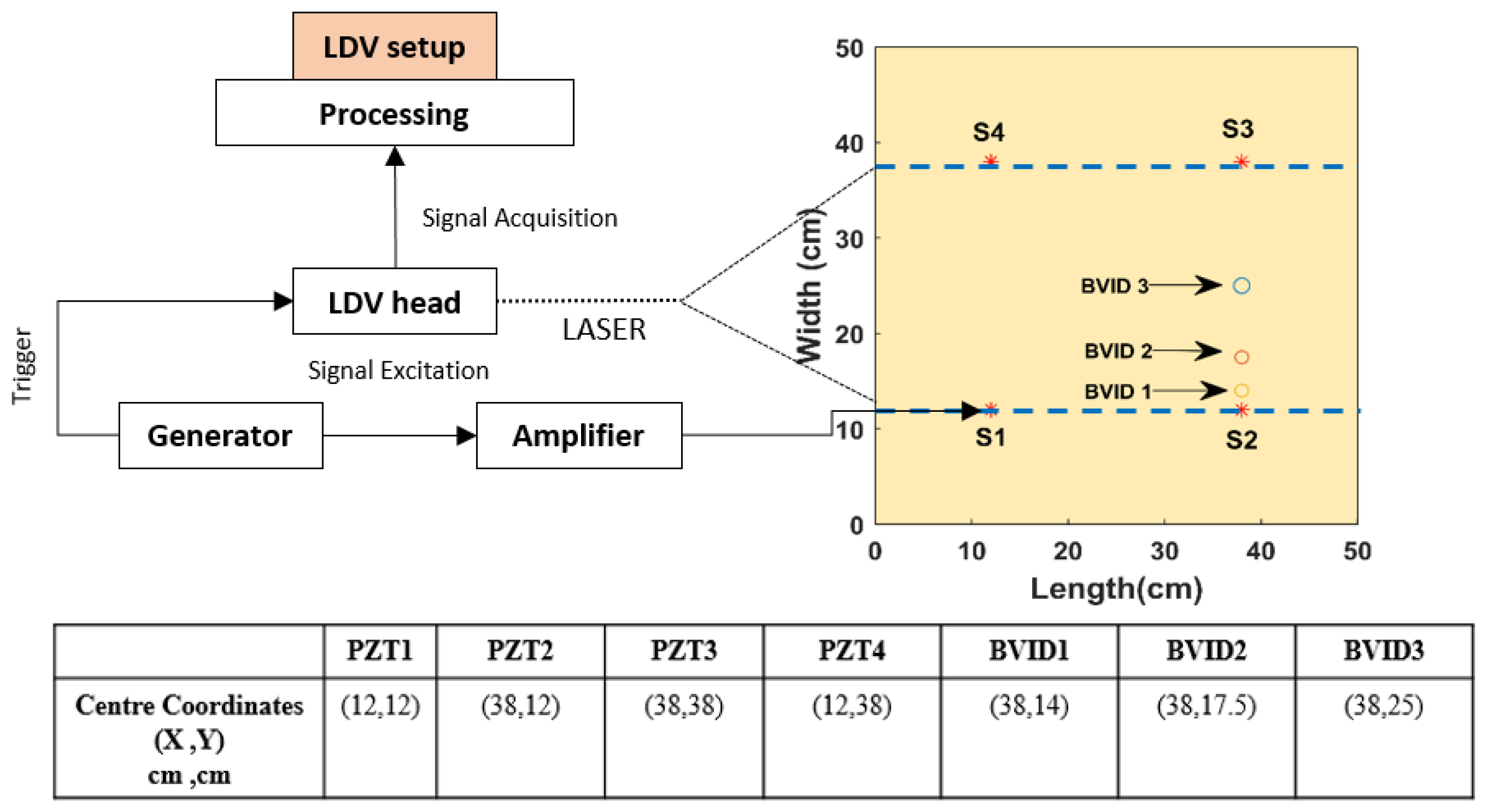

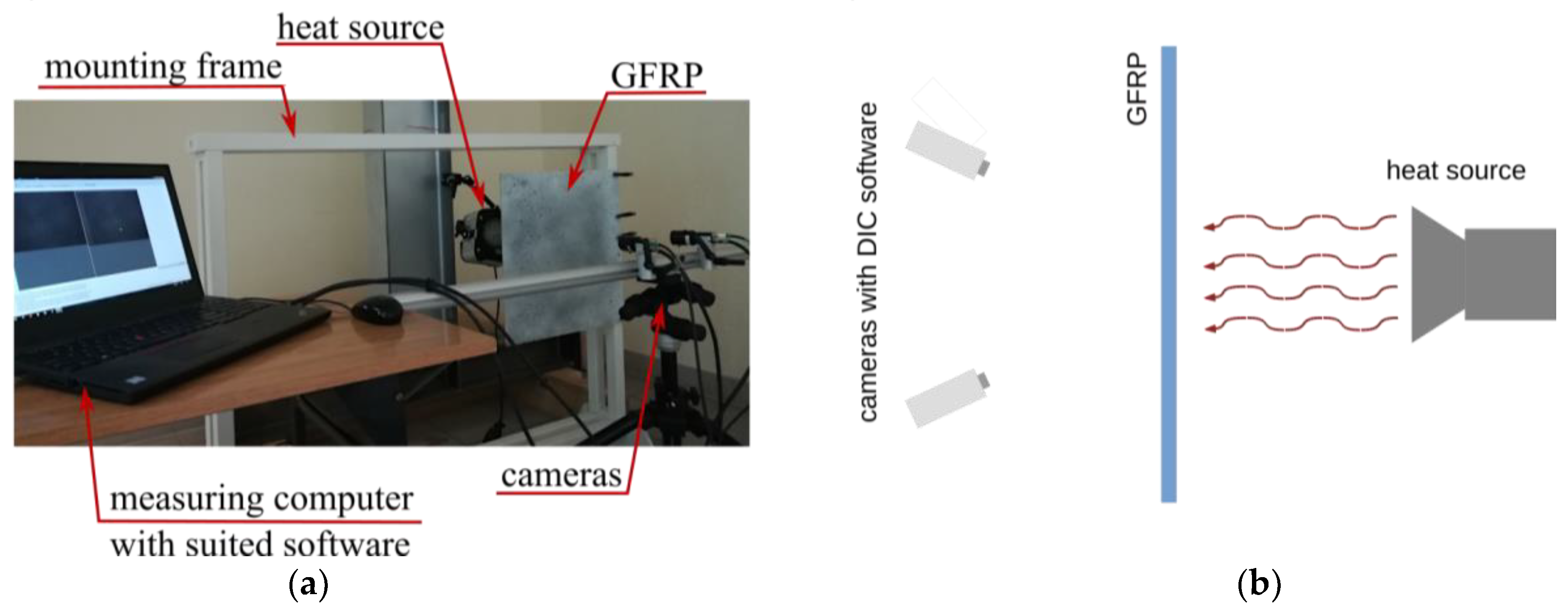


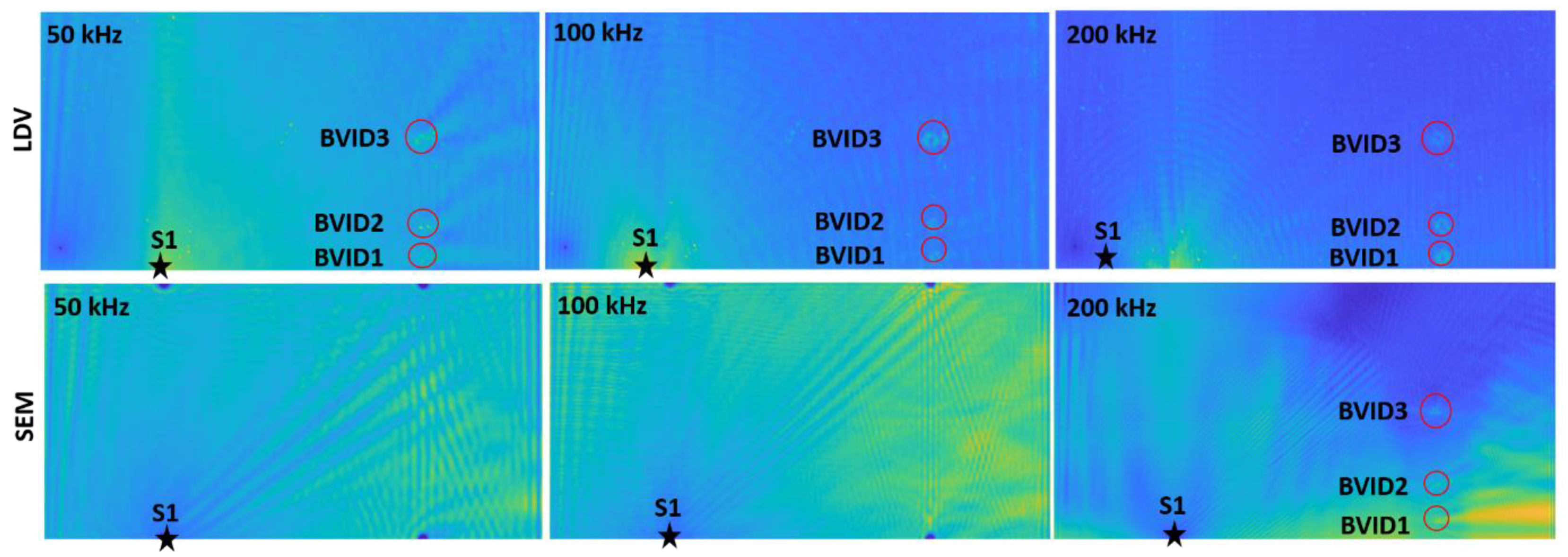


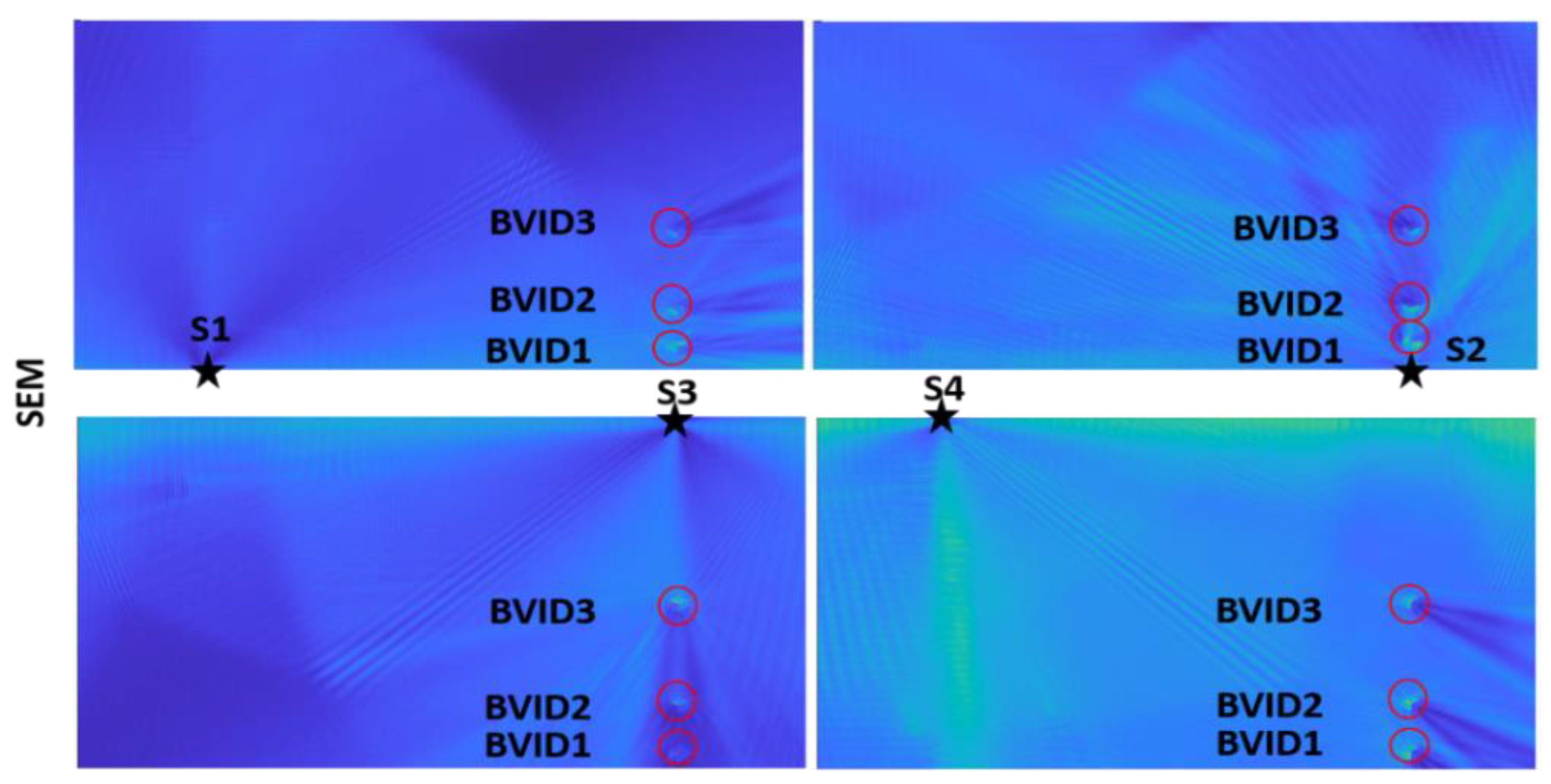
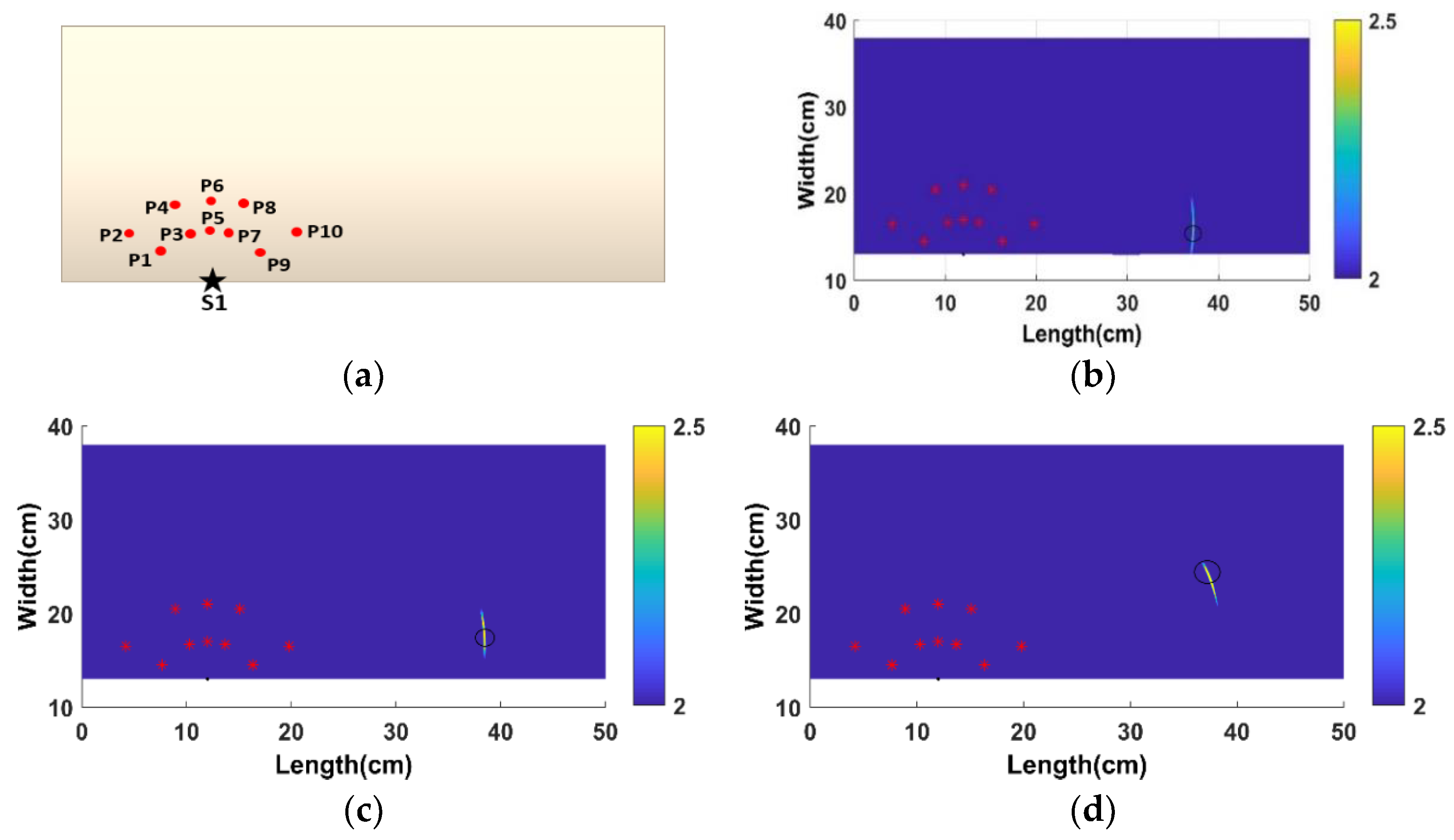

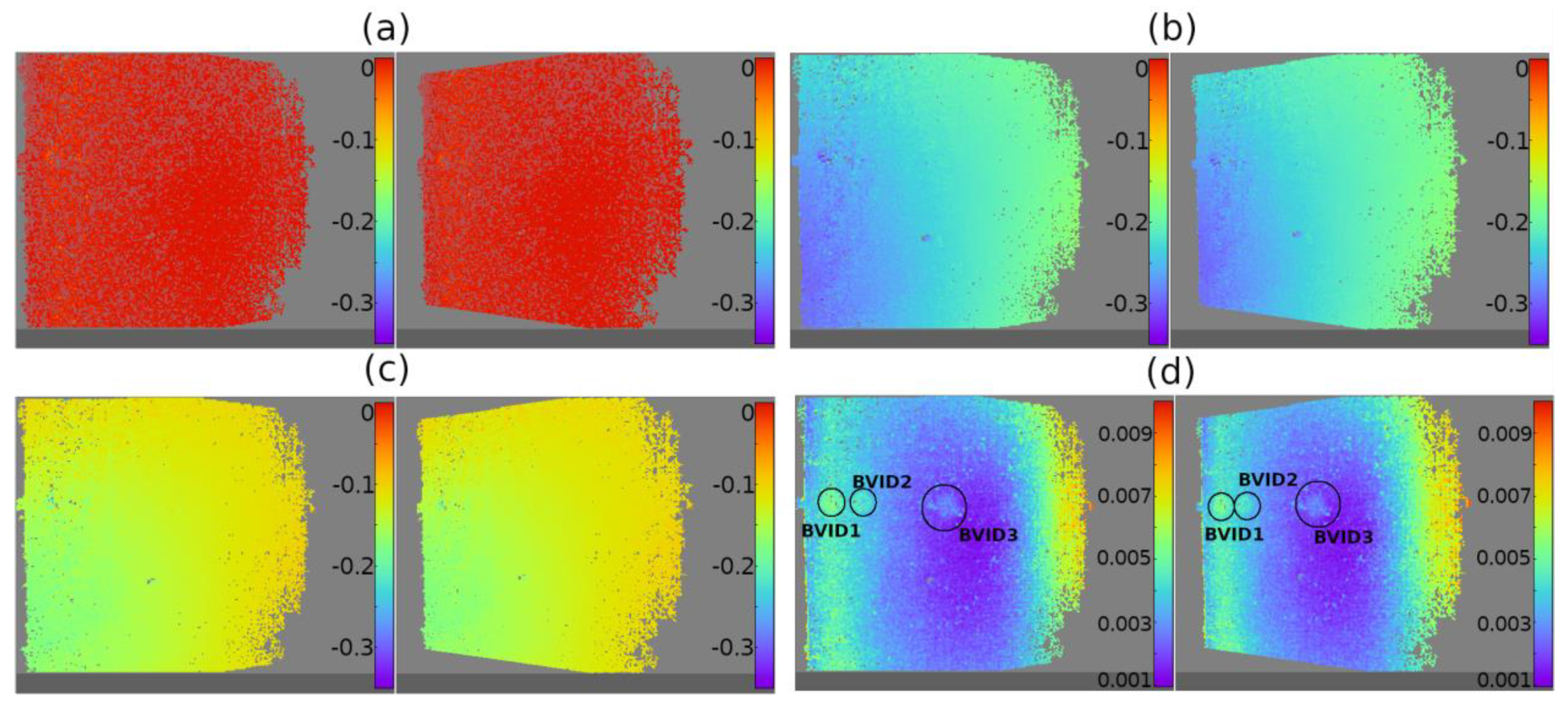
| Material | E11 | E22, E33 | G12 | G23 | ν12 | ν23 | ρ | V |
|---|---|---|---|---|---|---|---|---|
| GPa | GPa | GPa | GPa | - | - | kg/m3 | % | |
| Glass fiber | 75.0 | 75.0 | 30.70 | 30.70 | 0.22 | 0.22 | 2600 | 50 |
| Epoxy | 3.40 | 3.40 | 1.30 | 1.30 | 0.35 | 0.35 | 1250 | 50 |
| GFRP | 39.20 | 7.75 | 3.41 | 2.82 | 0.29 | 0.37 | 1925 | - |
| Case | 1 | 2 | 3 | 4 | 5 |
|---|---|---|---|---|---|
| Type | SEM | SEM | SEM | SEM | LDV |
| Model | BVID 1 | BVID 2 | BVID 3 | BVID 1,2,3 | BVID 1,2,3 |
| SEM Cases | Case 1 | Case 2 | Case 3 |
|---|---|---|---|
| Actual location (cm) | (38,14) | (38,17.5) | (38,24) |
| Estimated location (cm) | (38.3,13.4) | (38.5,17.4) | (37.4,24.1) |
| Difference (cm) | 0.67 | 0.50 | 0.60 |
| SEM and LDV Cases | Case 4 | Case 5 | ||||
|---|---|---|---|---|---|---|
| BVID1 | BVID2 | BVID3 | BVID1 | BVID2 | BVID3 | |
| Actual location (cm) | (38,14) | (38,17.5) | (38,24) | (38,14) | (38,17.5) | (38,24) |
| Estimated location (cm) | (38.7,13) | (38.6,17) | (37.7,24) | (38.3,13.9) | (38.3,17.3) | (37.2,24) |
| Difference (cm) | 0.74 | 0.60 | 0.76 | 0.32 | 0.34 | 0.89 |
Publisher’s Note: MDPI stays neutral with regard to jurisdictional claims in published maps and institutional affiliations. |
© 2021 by the authors. Licensee MDPI, Basel, Switzerland. This article is an open access article distributed under the terms and conditions of the Creative Commons Attribution (CC BY) license (https://creativecommons.org/licenses/by/4.0/).
Share and Cite
Balasubramaniam, K.; Ziaja, D.; Jurek, M.; Fiborek, P.; Malinowski, P. Experimental and Numerical Analysis of Multiple Low-Velocity Impact Damages in a Glass Fibered Composite Structure. Materials 2021, 14, 7268. https://doi.org/10.3390/ma14237268
Balasubramaniam K, Ziaja D, Jurek M, Fiborek P, Malinowski P. Experimental and Numerical Analysis of Multiple Low-Velocity Impact Damages in a Glass Fibered Composite Structure. Materials. 2021; 14(23):7268. https://doi.org/10.3390/ma14237268
Chicago/Turabian StyleBalasubramaniam, Kaleeswaran, Dominika Ziaja, Michał Jurek, Piotr Fiborek, and Paweł Malinowski. 2021. "Experimental and Numerical Analysis of Multiple Low-Velocity Impact Damages in a Glass Fibered Composite Structure" Materials 14, no. 23: 7268. https://doi.org/10.3390/ma14237268







